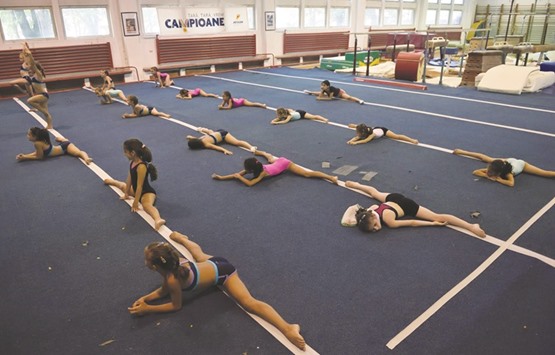Forty years after Nadia Comaneci produced one of the all-time great Olympic exploits in Montreal, hopes of Romania producing another such gymnast are hamstrung by scant finances.
Such has been the exodus of top coaches to better paid posts abroad that the Romanian women’s team failed to even qualify for the Rio Games.
They had previously been on the podium at every Olympics since Comaneci’s 1976 landmark uneven bars performance which earned the sport’s first ever perfect ten.
“These days fewer and fewer girls want to do gymnastics,” lamented former gymnast and current federal coach Anca Grigoras in an interview with AFP.
Nearby, two nine-year-olds, the joyful yet breathless Iana and Luiza, were resting after their routines in the national junior championships.
The pair insisted however that their three hours per day workouts are far from tiring, which is a far cry to the spartan regime Comaneci came through.
But Romania currently has just 300 active gymnasts and the feeling is that the life, and what has to be given up in pursuit of a medal for a hopeful gymnast, is too much for most.
Grigoras pinpointed the change of political system and the wider opportunities offered under the current democratic system that replaced communism after the 1989 revolution.
“Kids have a variety of less demanding activities on offer now,” she explained.
Under the former communist dictatorship of Nicolae Ceausescu, gymnastics was viewed as one of the rare opportunities to escape poverty, even if Romania’s wealth remains relatively modest in 2016.
Back in Comaneci’s day the sports academies took full charge of the young athletes. Now, sports funding by the state in all sports in Romania has been drastically reduced.
“The centres where the national teams train lack for nothing,” insists Grigoras. “But at school level and at the clubs there are grave problems.”
Creaking apparatus
The gymnastics facility at top club Dinamo Bucharest, whose Larisa Iordache won a team Olympic bronze in 2012 and a world championship bronze in 2015, “has not been renovated for 30 or 40 years now,” coach Mariana Campeanu said.
The children there work out on threadbare mattresses and using 20-year-old apparatus.
“Parents have to buy chalk powder, the outfits and actually pay for training courses, whereas before the clubs financed all that. So there is little surprise seeing children go in for other sports outside gymnastics,” she said.
“In the old days kids coming through into the national team just needed a bit of finishing, they were already high level,” she said explaining that the current crop are far from the same level as in the golden years.
Exodus of coaches
Many Romanians such as Dumitru Pop, who coaches the French women’s team, and Mihai Brestyan, who works for the United States women’s outfit, were pushed out of their home system by low wages.
“In Romania a young coach earns around 1,000 lei ($250) per month,” Campeanu said, adding that it was mainly men who had moved on and that their strength, lifting and catching gymnasts on the bars, was badly missed.
But Campeanu said she felt Romania’s failure to qualify for Rio had been a freak accident and pointed out that 28-year-old Catalina Ponor, a 2004 team gold medallist, had qualified individually and could well get the nation a medal.
“We have shown that even under these circumstances Romania might win a medal. The adversity maybe has a motivating effect.”

In this August 1, 2016, picture, Romanian gymnasts perform during a training session at Dinamo gymnastic club in Bucharest. (AFP)
